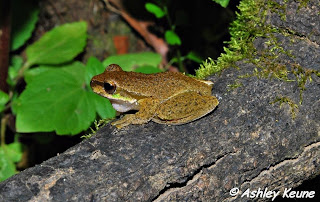Just as I was about to start recording them I heard several Tusked Frogs calling out on the underside of a massive log partially in the water. There were 3 within a few metres of one another, calling out between the bark which had peeled of the trunk and the log itself. Due to their location I was unable to obtain any photos of them. I did get a recording of one calling for a short period though before my recorder went flat. I can't believe I didn't charge it up before I left!!
This is a recording of one of the Tusked Frogs calling from beneath the log. In between the parts of the Tusked Frog call, you can hear some Pearson's Green Tree Frogs calling too.
I took some photos of several different individual specimens of the Pearson's Green Tree Frogs. I could see a large variety in colour between all of the frogs within a very small area. The closer to the water they seemed to be, the darker they were. I'm not sure if this is always the case or just a coincidence. This male had stopped calling by the time I took the photos.
 |
| Pearson's Green Tree Frog on a leaf just out of the flowing water |
 |
| Another Pearson's Green Tree Frog on branches about 20cm above the water |
 |
| The same Pearson's Green Tree Frog from above |
As I was moving towards the other side of the creek a couple of these frogs jumped out from the rocks near my feet. They were Wilcox's Frogs. This was only a small specimen that was about 2.5 - 3 cm in length. At first I was unsure due to the colour difference to the specimens that I find on my property but after looking at the photos closely I'm certain of this identification. The main reason I think that these are so different in colour to the ones that I have photographed on my property is because these are photos of females and all the photos I have put on this blog from my house are males.
 |
| Wilcox's Frog from above |
 |
| Female Wilcox's Frog |
 |
| The same Female Wilcox's Frog |
I was watching this Pearson's Green Tree Frog calling for quite a while and I was waiting for its air sack to inflate fully to get a photo. After watching it for more than 10 minutes I realised that when they call they do not inflate their air sack like some louder frogs do. The photos below were all taken during the advertising call of another Pearson's Green Tree Frog. I took many, many shots while it was calling and the air sack didn't inflate more than this in any shot. I watched several other specimens calling and they did not inflate their air sacks more than this during their call either. I assumed that they would inflate their air sacks like the Peron's Tree Frog and most other species that I have ever seen. This was very surprising to see. I would be interested to see if this is always the case during their call as I study them more over time.
 |
| This Pearson's Green Tree Frog was missing a little toe |
 |
| Pearson's Green Tree Frog |
 |
| Pearson's Green Tree Frog calling |
Just as I was making my way back out of the creek to climb up to the car I saw the biggest spider that I have seen in many years. I love nature but spiders are one thing that I do not particularly enjoy seeing. If they are still I am fine but if they come towards me, climb on me or if I walk through their webs I start to panic! This spider was approximately 25cm from leg tip to leg tip!!
 |
| This spider was 25cm in length |
I couldn't hear any other frogs calling out and the rain was starting to get heavier and I was unsure how much was coming so I decided to call it a night. There was no point in getting the camera wet as I have photos of all the frogs that I could see and/hear.
More pics and updates when more frogs are photographed and recorded.


























